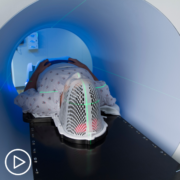Understanding Myeloma Testing and Monitoring | An Overview
Understanding Myeloma Testing and Monitoring | An Overview from Patient Empowerment Network on Vimeo.
What should patients know about myeloma treatment and testing? Dr. Sikander Ailawadhi shares an overview of myeloma testing and discusses the importance of getting key questions answered by your healthcare team.
Dr. Sikander Ailawadhi is a hematologist and oncologist specializing in myeloma at Mayo Clinic in Jacksonville, Florida. Learn more about Dr. Ailawadhi.
Related Resources:

Key Advice for Myeloma Patients | Questions to Ask About a Care Plan |

Accessing Quality Myeloma Care | Advice for Overcoming Obstacles |

Available Myeloma Treatment Options for Patients | An Overview |
Transcript:
Katherine:
What sort of tests should be done following a myeloma diagnosis?
Dr. Ailawadhi:
Generally, when myeloma is suspected, we need to know what the basic blood counts are, something that is called a CBC, complete blood count. We’re looking for anemia, low white blood cells, low clotting cells, or platelets. We want to do serum chemistries or blood chemistries, looking for kidney function, liver function, electrolytes, calcium, et cetera.
Then, we want to do some kind of an imaging of the body. Generally, routine X-rays are no longer done, and the most preferred is a PET-CT scan, a PET scan. We do PET-MRIs frequently. So, there are different tests available, but you want a good test to know what’s the state of bones and presence of any lesions or tumors. And then, the important question comes is doing a bone marrow biopsy.
The reason for doing a bone marrow biopsy, and even if somebody has had a biopsy done from a compression fracture, et cetera, that diagnosed myeloma, a bone marrow biopsy still should be done. It gives us a lot of pieces of information.
It tells us what is the percentage of plasma cells in the bone marrow. So, what is the disease burden we are starting with? Secondly, that bone marrow biopsy specimen can be sent for what is called a FISH testing, which is fluorescent in situ hybridization.
It is basically looking for any mutations in the cancer cells. Based on those mutations, myeloma can be classified into standard or high-risk myeloma. And sometimes our treatment choices are differed based on whether somebody is standard or high-risk. So, blood work, basic counts – and I skipped over one of the things. Right after chemistries, I wanted to add also are myeloma markers.
There are typically three lab tests of myeloma markers. One is called protein electrophoresis. It can be run in blood and urine. Ideally, it should be run in both. One is immunoglobulin levels, which gives us the level of IgG, IgA, IgM, et cetera. And the third one is serum-free light chains, which is kappa and lambda light chains. Neither one – none of these tests eliminates the needs for the other.
So, everybody, in the beginning, should have complete blood count, blood chemistries, SPEP or serum protein electrophoresis, urine electrophoresis, immunoglobulins, light chains, imaging, and then a bone marrow. This completes the workup. Then, based on that, the treatment can be determined.
Katherine:
Well, you mentioned lab work. How often should tests and blood work be done?
Dr. Ailawadhi:
Good question. Very, very important question because we see very frequently that the patients come in, they’re getting treatment somewhere, and every single time the patient steps foot in the door of that institution or wherever they’re going, they got a blood draw. That’s how they start their day. It’s needed more frequently in the beginning but needed less frequently later on.
Generally, the myeloma markers, those protein electrophoresis, immunoglobulins, light chains, they are frequently done just about every month. Generally, in myeloma, one month, three to four weeks is one cycle. So, at the beginning of every cycle, you want to know how good your response was. So, the myeloma markers once a month.
The blood counts and chemistries in the first month, first one to two months, they can be done every other week or so just to make sure counts are fine, no need for transfusions, kidney/liver is okay, et cetera. But after the first couple of months, when the body is used to the drugs when the patient is settled with the treatment, frankly, once-a-month labs are good enough. We don’t really need labs on every single treatment visit. Because the other thing that happens is some of these drugs can lower the blood counts normally during treatment, but they have a rest period at the end of the cycle when the counts recover.
So, if somebody does labs in the middle of the cycle when the counts are expected to be down but not an issue, treatments are stopped, and growth factors are given. And this is done, but that is not really necessary. So, first couple of one to two cycles, maybe every other week to make sure counts are okay. Myeloma markers monthly, but after the first couple of months when things are settled, once a month should be sufficient.
Katherine:
Okay. What questions should patients be asking about their test results?
Dr. Ailawadhi:
Yeah. Very, very, very important. In fact, whenever I’m speaking in a patient caregiver symposium or anything, I spend a lot of time on these test results because frankly, a lot of times it sounds like jargon and the people talk about, “Oh, my ratio is going up,” or the doctor is saying, “Hey, your immunoglobulins are normal. You’re in remission.” But so, I think the patients need to understand and ask from their doctors, “What is my marker of the disease that you will be following?” And I’ll tell you that immunoglobulins, that IgG or IgA level, is nearly never the marker. It’s either M spike or light chains, generally one of those.
So, the patients need to understand what is their marker. They also need to know what did their bone marrow show. What was the percentage and what was the FISH result or cytogenetic result? I think other than the tests, I will also add the patients need to ask their doctor a lot of these questions that you’re asking me. How frequently are the labs going to be done? Why is it important? Why was a certain treatment selected? What is the expected outcome? What are the chances that I can go into remission? How long does the intense treatment stay?
When does it go to some kind of a maintenance? Et cetera, et cetera. Basically, you want to understand everything about the disease and its treatment. It is overwhelming. This is a lot of information. A lot of times the patients may say, “Well, I got a diagnosis. I got a treatment started. I just need to move on.” That’s right. But once you spend all that time initially understanding your diagnosis and the treatment and the disease, it’ll make the rest of the journey much, much easier.




![Dr. Shah's [ACT]IVATION Tip](https://powerfulpatients.org/wp-content/uploads/Screenshot-2023-08-14-at-10.37.31-AM-1030x550.png)















